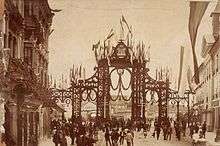1895 visit of Emperor Franz Joseph to Zagreb
In mid-October 1895, Austro-Hungarian Emperor Franz Joseph visited Zagreb, at the time the capital of the Kingdom of Croatia-Slavonia, in order to attend the opening of the Croatian National Theatre. A group of Croatian students used the visit to protest the rule of the Hungarian Károly Khuen-Héderváry as Croatian ban. They were led by Stjepan Radić, who would later form the influential Croatian People's Peasant Party.
Events

The emperor arrived in Zagreb by train on October 14, 1895. Upon his arrival a group of students chanted "Slava Jelačiću" ("Glory to Jelačić"), in reference to the former Croatian ban Josip Jelačić who had risen up against the Hungarians in the Revolutions of 1848. That day the emperor attended the unveiling ceremonial completion of the Croatian National Theatre.[2] Music by Ivan Zajc was subsequently performed inside the theatre.
The following day, the emperor attended an honorary dance at the Kolo building.[2] On this day a group of students led by Stjepan Radić planned a burning of the Hungarian tricolour.
On October 16, the final day of the imperial visit, the students marched to Ban Jelačić Square where they chanted "Živio hrvatski kralj Franjo Josip I" ("Long live Croatian king Franz Joseph I"), "Slava Jelačiću" and "Abzug Magjari" ("Away with Hungarians"). They doused the Hungarian tricolour in brandy and set it on fire. They then marched towards the University of Zagreb. The city police soon informed ban Khuen-Héderváry of the act and the students were arrested.
Aftermath
The students were subsequently charged for the incident. Stjepan Radić was sentenced to six months in jail, Gjuro Balaško to five, and Milan Dorwald, Osman Hadžić, Vladimir Vidrić, Josip Šikutrić, Vladimir Frank and Ivan Fran to four months. The students were all barred from the University of Zagreb while Stjepan Radić was barred from all universities in the empire. This led him to continue his studies abroad in Paris. The other students went to the Charles University in Prague and the University of Vienna.
These students would form the basis of the Croatian Moderna. In 1897, the Prague group of students began publishing Hrvatska misao, while in 1898 the Vienna students began publishing Mladost.[3]
The flag burning also resulted in a split between the Croatian Party of Rights and the Croatian Pure Party of Rights who disagreed on the flag-burning.
See also
Notes
References
- "Svečana sablja sveučilišnih građana zagrebačkog sveučilišta iz 1895. godine" [Honorary saber of the university students of 1895]. Retrieved 12 January 2015.
- Racko, Ljerka (October 1990). "Spaljivanje mađarske zastave 1895. godine u Zagrebu" (PDF). Radovi Zavoda za hrvatsku povijest (in Croatian). 23 (1): 233–246. Retrieved 12 January 2015.